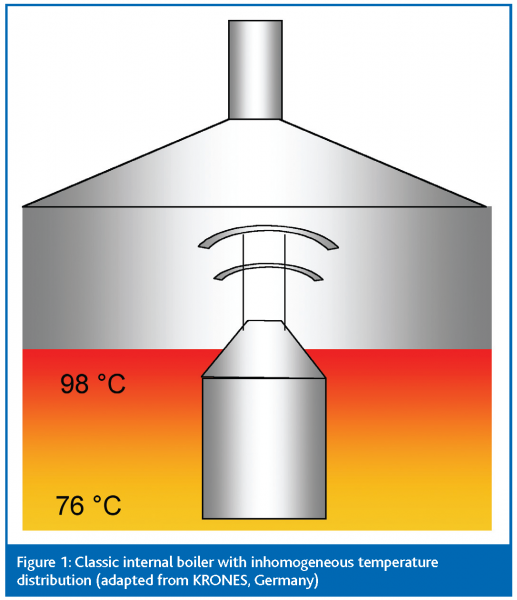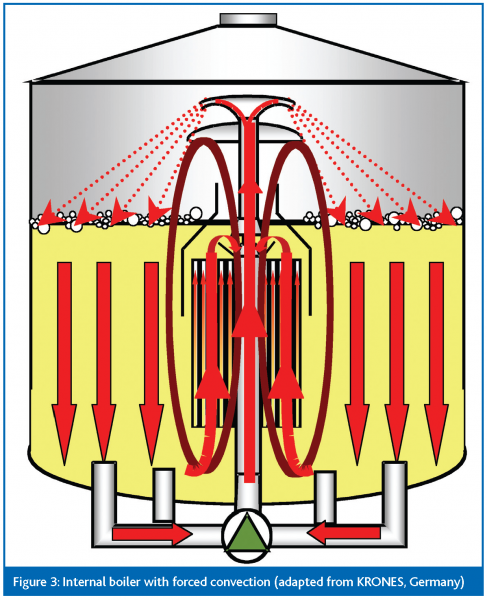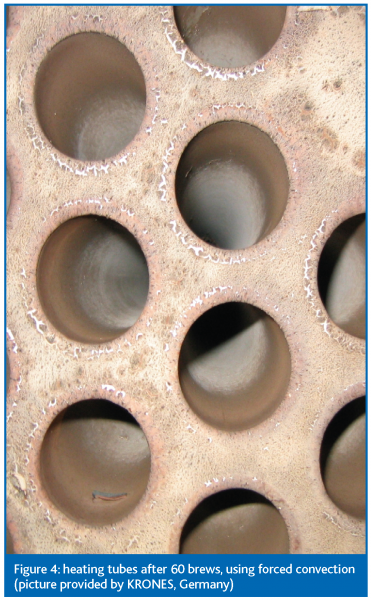Trends in brewing technology – wort boiling
Posted: 6 November 2006 | David De Schutter, PhD Fellow, Centre for Malting & Brewing Science, Faculty of Bioscience Engineering – KULeuven | No comments yet
Being one of the oldest industries in the world, the brewing industry still experiences many technological improvements. These innovations are mainly driven by the continuous quest for energy savings and therefore cost-reduction, while keeping one eye on the quality of the finished product.
Beer brewing is a highly energy-dependent process. The majority of thermal energy is consumed in the brewhouse, the place where the raw materials of beer are converted into wort. First barley malt is milled and added to warm water (mashing-in), after which this mash is subjected to a highly regulated temperature program in order to activate specific enzymes, which will degrade the malt into fermentable substrates. Proteases are activated at 55°C, while β- and α-amylases will be activated at 63°C and 72°C, respectively. This enzymatic activity leads to the solubilisation of glucose, maltose, maltotriose, co-factors, proteins and amino acids. After the mashing process the temperature is raised to 78°C in order to inactivate the enzymes, before the mash is transferred to the lauter tun. During filtration the water-soluble substances (the wort extract) are separated from the spent grains and these spent grains will be washed with hot water until a maximum efficiency of extraction is reached. The resulting sweet wort is then heated to boiling temperature in the boiling kettle and hops are added. After approximately one hour of boiling, the wort is transferred to a whirlpool, where solid particles (hop rests and coagulated proteins) are separated from the bitter wort. Finally, the wort will be cooled down through a plate heat exchanger, oxygenated and transported to the fermentation cellar, where yeast is added to start the fermentation.
Being one of the oldest industries in the world, the brewing industry still experiences many technological improvements. These innovations are mainly driven by the continuous quest for energy savings and therefore cost-reduction, while keeping one eye on the quality of the finished product. Beer brewing is a highly energy-dependent process. The majority of thermal energy is consumed in the brewhouse, the place where the raw materials of beer are converted into wort. First barley malt is milled and added to warm water (mashing-in), after which this mash is subjected to a highly regulated temperature program in order to activate specific enzymes, which will degrade the malt into fermentable substrates. Proteases are activated at 55°C, while β- and α-amylases will be activated at 63°C and 72°C, respectively. This enzymatic activity leads to the solubilisation of glucose, maltose, maltotriose, co-factors, proteins and amino acids. After the mashing process the temperature is raised to 78°C in order to inactivate the enzymes, before the mash is transferred to the lauter tun. During filtration the water-soluble substances (the wort extract) are separated from the spent grains and these spent grains will be washed with hot water until a maximum efficiency of extraction is reached. The resulting sweet wort is then heated to boiling temperature in the boiling kettle and hops are added. After approximately one hour of boiling, the wort is transferred to a whirlpool, where solid particles (hop rests and coagulated proteins) are separated from the bitter wort. Finally, the wort will be cooled down through a plate heat exchanger, oxygenated and transported to the fermentation cellar, where yeast is added to start the fermentation.
Being one of the oldest industries in the world, the brewing industry still experiences many technological improvements. These innovations are mainly driven by the continuous quest for energy savings and therefore cost-reduction, while keeping one eye on the quality of the finished product. Beer brewing is a highly energy-dependent process. The majority of thermal energy is consumed in the brewhouse, the place where the raw materials of beer are converted into wort. First barley malt is milled and added to warm water (mashing-in), after which this mash is subjected to a highly regulated temperature program in order to activate specific enzymes, which will degrade the malt into fermentable substrates.
Proteases are activated at 55°C, while β- and α-amylases will be activated at 63°C and 72°C, respectively. This enzymatic activity leads to the solubilisation of glucose, maltose, maltotriose, co-factors, proteins and amino acids. After the mashing process the temperature is raised to 78°C in order to inactivate the enzymes, before the mash is transferred to the lauter tun. During filtration the water-soluble substances (the wort extract) are separated from the spent grains and these spent grains will be washed with hot water until a maximum efficiency of extraction is reached. The resulting sweet wort is then heated to boiling temperature in the boiling kettle and hops are added. After approximately one hour of boiling, the wort is transferred to a whirlpool, where solid particles (hop rests and coagulated proteins) are separated from the bitter wort. Finally, the wort will be cooled down through a plate heat exchanger, oxygenated and transported to the fermentation cellar, where yeast is added to start the fermentation.
During fermentation, the fermentable sugars will be converted to alcohol, CO2 and secondary metabolites. The flavour profile of the finished beer will depend on the yeast strain and the variation of all production parameters. Evidently, there are millions of different possibilities. In this short review, we will focus on recent developments in the brewhouse and, more specifically, the wort boiling process, compared to classic wort boiling. The wort boiling process should not be underestimated, because it plays a crucial role in wort production by serving numerous vital objectives. These include:
- Wort sterilisation
- Termination of enzymatic activity
- Isomerisation of hop α-acids in iso-α-acids
- Coagulation of haze-active proteins and preservation of foam-positive proteins and peptides
- Evaporation of unwanted flavour volatiles
- Formation of taste compounds and desirable aroma compounds
- Achievement of the desired colour and concentration of the finished wort to final gravity
Obviously, these requirements are not easily fulfilled. Measurements taken to optimise a certain process parameter can have an adverse effect on other parameters. For instance, wort has to be boiled in order to precipitate unwanted haze-active proteins, while other foam-stabilising proteins have to remain in solution. If boiled too extensively, the total protein content of the wort (and consequently the beer) will be very low, making it barely able to support foam formation and it will especially affect the foam stability of the finished beer. Moreover, some volatiles in wort must be evaporated almost entirely. One such volatile – termed dimethylsulphide (DMS) – possesses a flavour perception, which is often described as cooked cabbage or sweet corn. In high concentrations this compound is extremely undesirable in beer, but in low concentrations its presence can have a beneficial effect on the flavour of lager beer. On the other hand, while evaporating, heat is constantly applied to the wort, generating Maillard reactions and consequently an increase in colour of wort and beer. Lager beer should be pale and therefore an increased beer colour will decrease the consumer appreciation.
The internal boiler: a ‘classic’ boiling system
Since the late 1970s the most frequently applied boiling system consists of an internal boiler to heat up the wort in the brewing kettle (Figure 1). An internal boiler contains vertically oriented heating tubes and live steam is used to provide the necessary energy. In the heating tubes wort will be heated to boiling temperature until vapour bubbles arise. The upward movement of the vapour bubbles will force the boiling wort to move through the internal boiler and leave the boiler at the surface, where evaporation of volatiles occurs. This so-called thermosiphon principle is simple and no other agitation is needed to circulate the wort in the vessel. However, there are some drawbacks. After filtration, wort of 72°C will be transferred to the boiling kettle and this cooler wort will enter the heating tubes. At this stage the temperature is far from boiling temperature, so it takes a while before the wort reaches the boiling temperature in the heating tubes. This causes a temporary interruption in the upward movement of the wort until the boiling temperature is reached. Then the boiling wort will leave the heating tubes, where it is quickly replaced by cooler wort. This phenomenon is known as pulsation and will last until the wort will reach near boiling temperatures.\ A second drawback is the heat-dependency of the wort circulation through the tube bundles. In order to ensure the homogeneous circulation in the kettle, a certain temperature difference must exist between the heating medium and the brewing liquor. This coexists with local over-heating at the interface between heat bundle and wort, leading to burning and fouling on the tubes (Figure 2). Fouling reduces the heating efficiency and can cause a burnt taste and an increased colour in beer.
Recent improvements of brewing technology
For a long time, only atmospheric boiling has been applied in beer brewing. Apart from unpleasant odour emissions in the neighbourhood of a brewery, a lot of energy is also lost if no vapour recuperation is applied. Assuming that 8-12 % of the total volume of wort will be evaporated in classic brewing systems, it is not hard to imagine that huge savings can be obtained by simply reducing the evaporation to no more than 5-6 %, combined with vapour condensation. If in a brewery with a 500 hl brewhouse the evaporation is reduced from 12 % to 6 %, savings per brew will be almost 6.8 MJ per brew, even without energy recuperation of the produced wort vapours. It is not difficult to imagine how quickly the investment of a new brewhouse will be paid back Over the last decade, there has been a dramatic evolution in innovative boiling technologies. Instead of heating up to boiling temperature inside the wort kettle, more and more breweries are using plate heat exchangers during the transfer of wort to the boiling kettle. In the exchanger, hot water of 98°C is used in counter-current to heat wort from 72 to 96°C. This method of heating is far gentler than heating with an internal boiler, because the temperature never exceeds boiling temperature. Moreover, this approach provides an excellent means for energy recuperation of wort vapours during boiling. The hot water leaves the heat exchanger at 78°C and will be stored in the heat storage tank. Then it will be reheated to 98°C in the vapour condensation unit. Thus, the energy of the wort vapours is recovered in the heating stage of wort processing. Nowadays there exists a wide range of boiling systems meeting the requirements of a brewer, such as ‘vacuum boiling’, external boilers with thermosiphon characteristics; ‘gentle boiling’ (Kaspar Schultz, Germany); ‘dynamic wort boiling’ (Huppmann, Germany); continuous wort boiling (Meura, Belgium); boiling with thin-film evaporation and the use of an internal boiler with forced convection (both Krones, Germany). Each of these technologies strives to reduce the total evaporation to no more than 4-8 per cent. Reduced evaporation can be obtained simultaneously by shortening the boiling stage and by enhancing the specific evaporation of unwanted volatiles. The internal boiling system with forced convection, for instance, is a simple adaptation of the classic system (Figure 3). At the bottom of the kettle, wort is withdrawn and pumped through the heating tubes. This way the frequency-controlled pump contributes to the natural thermosiphon movement inside the heating tubes. Above these heating tubes, a jet pump is installed which sucks the wort out of the tubes to a wort deflector. This deflector spreads the wort evenly over the surface, maximising the contact between the liquid and gas phase of the boiling wort and thus optimising the evaporation of unwanted volatiles. As heating and convection in the boiling kettle are no longer linked together, a much lower steam pressure is required for application in the heating tubes, resulting in a more ‘gentle’ boiling process. Consequently, fouling of the internal boiler will be reduced to a minimal level and the number of brews between cleaning cycles can be increased considerably (Figure 4). Evidently it is beneficial to the environment if the amount of wastewater and the use of cleaning chemicals can be reduced. Moreover, the efficiency of the brewhouse will increase and more brews can also be produced.
Future perspectives
The quest for the ultimate boiling technology is not yet complete. Over the last decade brewing technology has advanced considerably to effect a more efficient use of energy. Further research has to be made to increase this efficiency, without forgetting to improve beer quality, which still remains a major concern to the brewer. Microbiological and colloidal stability of beer are already largely under control, but flavour stability and the effect of process parameters on this stability remains a heavily investigated challenge. A lot of effort has to be made by the brewer to keep the quality of his beer undisputed and a modern boiling kettle can help him to achieve this. Manufacturers respond to this by offering innovative boiling technology, but they must never forget the basic engineering principle: keep it simple. 











